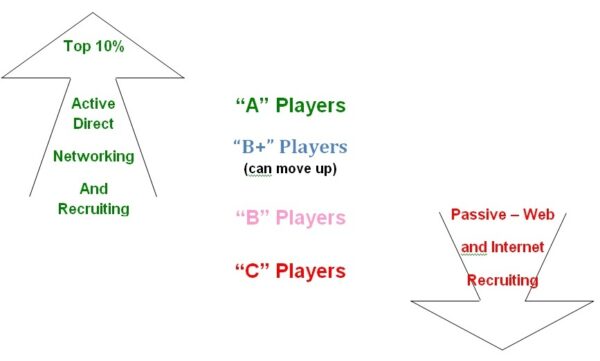
Talent Wins and Performance Shows
by Peter Cotton, founder and president of Best Sales Talent, LLC (with a posthumous thank you to Ron Fink, former President of The Lewis Group for his thoughts and insight on this subject. Special thanks to Fred Raley, President of Olon Search & Consulting Group and Jack Bourque, President of Wireless Careers, for their contributions to the content of this post.
This is an update to the post with the same title of May 2013
In order for companies to beat their competitors in the marketplace, and to remain competitive, they must be skilled at identifying, attracting, and hiring top talent. Being effective at those skills is not all that is necessary, however. Companies must be equally skilled at retaining the top talent they hire. They need to create an environment where their best employees feel valued. When top talent is recognized for their contribution to the company, they feel connected to the organization’s mission and they become very loyal to their employer. This greatly reduces the probability that these employees will even consider going to the competition. The company size is often not the criteria for success – talent, properly employed and valued IS.
The most talented people are the people who make a real impact on the company – the ones who do their job and then some. The most talented people are individuals that give back disproportionate value to their employers. They bring more than skill. They bring energy and passion. And their effort doesn’t end just because the day has. In the recruiting world, we call these employees the “A” Players.
Famed author and consultant, Peter Drucker, Ph.D. said: “The ability to make good decisions regarding people represents one of the last reliable sources of competitive advantage, since so few companies are very good at it.”
Lawrence A. Bossidy Chairman and CEO of Allied Signal said: “No company can expect to beat the competition unless it has the best human capital and promotes these people to pivotal positions.”
Bradford D. Smart Ph.D., author of Topgrading said: “The single most important driver of organizational performance and individual managerial success is talent. The ability to actually do what every company and every manager professes to do – hire the best – is what distinguishes premier companies from mediocre firms and successful versus ordinary (management) careers.”
“A” Players figure out how to make valuable management initiatives work and “C” Players kill good ideas. Five percent of companies are ‘top-graders’; they pack their teams with “A” Players. The rest ‘make do’ with a few “A” Players, a bunch of “B” Players, and enough “C” Players to cause problems for everyone.”
“A” Players are defined as the top 10% of talent available at all salary levels – best of class.”

Let’s look more closely at what makes “A,” “B,” and “C Players”
“A” Players manage their careers and make their own decisions about their professional growth. “C” and some “B” Players allow the company they work for to manage their careers and make decisions about the career path for them.
If an “A” Player is working at a “B” or “C” company, they will actively seek a change as soon as possible so they can move up to work at an “A” company.
“A” Players know that companies who pack their teams with the most “A” Players at every level will always win.
“A” Players want to play on “A” teams.
“A” Players are the top 10% level of performers in every company, at their respective job, and at their pay levels.
“A” Players make things happen.
“B” Players watch things happen.
“C” Players wonder what happened.
“A” Players are well-known in their industries. Only some “B” Players are known in their industry. “C” Players are not known in their industry.
“A” Players will not put their jobs at risk by broadcasting their resumes on job boards. In fact, they are not looking at job boards and they are not responding to Internet job postings.
Let’s look more closely at what makes an “A” (& “B+”) Company:
“A” companies provide an environment that both challenges top talent and supports their growth at every level.
“A” companies sell the opportunity to recruits. They don’t sell the job duties and requirements.
“A” companies demonstrate that they are a decisive company by making hires of top talent quickly.
“A” companies make attractive offers to “A” Players and are willing to pay top dollar for top talent, because they know it is a wise investment.
“B” and “C” companies interrogate candidates on interviews and drag their feet when it comes to making hiring decisions.
“B” and “C” companies sell candidates on the job duties and responsibilities. They don’t know how to properly sell the opportunity to candidates.
“B” and “C” companies do not pay top dollar for top talent and therefore cannot compete in attracting them. They lose top talent to their competition – the “A” companies.
“A” and “B+” companies competitively reward “A” Players for their performance and invest in training “B+” Players to become “A” Players.”
“A” and “B+” companies recognize that talent without performance has no value, but talent without a place to perform only produces frustration or complacency. This is the primary reason why “A” Players do not stay in “B” companies or even considering joining “C” companies. “A” companies know this, while it never occurs to a “C” company.
“A” Players know that they cannot self-actualize in “B” companies unless they have been hired with the mandate to help move the “B” company into an “A” position – and upper management is in full support of the transition.
“B” Companies:
Look for talent, but are often unwilling to pay for it.
They find it difficult to attract top talent because they are unable to accept and act on the cost/value proposition. Therefore, they employ mostly “B” and “C” Players.
“B” companies have no specific plan to employ, challenge and reward “A” Players.
“B” companies hire only after a position has become vacant – sometimes long afterwards. They only speak to candidates when they need to fill a position. They never entertain a conversation with a top player in the industry if they have no job opening. They never think of top grading their team. When they do interview to fill an open position, they try to attract the best person they can for compensation they are willing to pay, which many times is a low-ball offer.
“B” companies are followers. They follow rather than lead in their markets, avoid change, and are slow to make decisions. When they do make decisions, they tend to make them based on internal politics.
“B” companies say: “Because that’s the way we have always done it.” It is a typical response to a new idea.
“A” Players avoid “B” companies. If they find themselves working in a “B” company, they change as soon as possible to get into an “A” company.
“A” Players who stay in “B” companies become “B” Players.
“C” Companies:
“C” companies cannot attract top talent. They are mired in bureaucracy, focused on survival and maintaining the status-quo.
“C” companies employ the greatest number of “C” players of any company in their industry sectors.

Active, direct recruiting is purposeful. It targets “A” and “B+” Players. For the most part these people are employed, relatively challenged and relatively happy. They are well compensated within their job categories and are “not looking.” They are not surfing the Internet looking for jobs and in most cases, their resumes are not up to date. They can however, be attracted to the right opportunity if a trained professional recruiter invests the time to find them, and who gains their confidence through conversation to learn of their needs, aspirations and desires. Only then can a professional sell an opportunity in just the right way – in a way to address the candidate’s needs, aspirations and desires. And if the opportunity is not a fit, the recruiter will tell the candidate that is the case. The candidate now appreciates that the recruiter can call again with a different opportunity at a future date. Employers who approach these candidates directly cannot offer that to them. [Think: fishing for a big fish in a lake. You approach quietly in a canoe and use a good lure. You don’t barge in on the scene in a noisy speed boat and shoot at the water with a shotgun. Likewise, a good recruiter doesn’t launch into selling the job to the candidate as soon as they begin speaking. He doesn’t sell an opportunity to a candidate unless, and until, he knows the candidate’s needs, aspirations and desires.]
Passive, Internet and web recruiting targets “B” Players (many of whom have peaked) and “C” Players. While this type of recruiting can, from time to time, reach a “B+”, or even an “A” Player, it relies completely on chance to do so. Employers post a job and wait for people to respond, or they send out emails to people waiting for a reply. That’s why it is called a passive process. “A” and “B+” players do not “float” their resumes on the net. They do not need or want that kind of exposure. Although there can be exceptions, for the most part, passive Internet or web-based recruiting attracts the best and the worst of the unemployed or the employed lookers. It also requires significantly more time to weed through an enormous number of responses from unqualified wannabes.
THE BIG TEST QUESTION
If you want to hire “A” and “B+” players, ask yourself; “Why would an “A” or “B+” player leave his or her present position to take a new position with YOUR company?”
[A posthumous thank you to Ron Fink, former President of The Lewis Group for his thoughts and insight on this subject. Special thanks to Fred Raley, President of Olon Search & Consulting Group and Jack Bourque, President of Wireless Careers, for their contributions to the content of this post.]
Peter Cotton is an executive recruiter with over 40 years of experience. He is the Founder and President of Best Sales Talent, LLC., a Franklin, MA executive search firm specializing in search, recruitment and placement of the very best sales, sales management and marketing personnel.
Website: www.bestsalestalent.com
Facebook: https://www.facebook.com/BestSalesTalent
X: @pcotton






